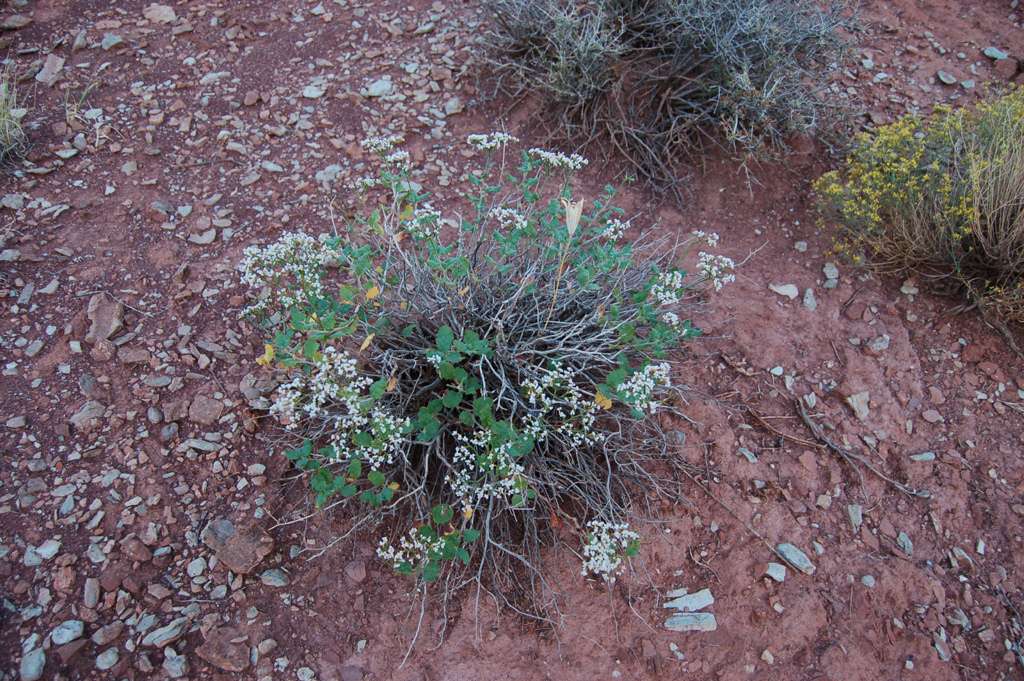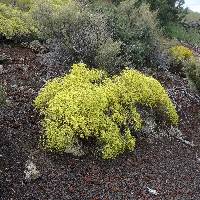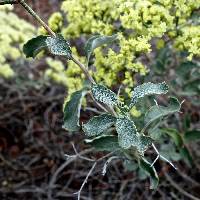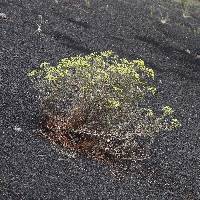Shrubs or subshrubs, spreading, rounded, occasionally erect, rarely somewhat matted, not scapose, (0.5-)1.5-8(-15) × (2-)3-15(-23) dm, grayish- to reddish-brown-tomentose to floccose or glabrous, grayish or greenish. Stems spreading or erect, often with persistent leaf bases, up to 3/ 4 or more height of plant; caudex stems absent or somewhat matted; aerial flowering stems erect or nearly so, slender or occasionally stout, solid, not fistulose, (0.1-)1-2 dm, tomentose to floccose, occasionally glabrous. Leaves cauline, 1 per node; petiole 0.1-1.5 cm, tomentose to floccose; blade lanceolate to oblanceolate or elliptic to nearly orbiculate, rarely cordate, (0.5-)1-3(-4.5) × (0.3-)0.5-3(-3.5) cm, densely white-, tannish- or brownish-tomentose on both surfaces or less so to nearly glabrous and green adaxially, margins occasionally crenulate. Inflorescences cymose, rarely capitate or umbellate, diffuse to rather open, (1-)3-20 × 2-25(-30) cm; branches dichotomous, tomentose, floccose, or rarely glabrous; bracts 3, scalelike, usually triangular, and 1-3(-6) mm, or leaflike, 10-25 mm, and similar to leaf blades. Peduncles absent. Involucres 1 per node, turbinate, (1-)1.5-3.5 × 1-2(-2.5) mm; teeth 5, erect, 0.3-1 mm. Flowers (1.5-)2-3.5 mm; perianth white to cream, pink, or pale yellow to yellow, glabrous or rarely sparsely pilose; tepals connate proximal 4- 3, essentially monomorphic, oblanceolate to spatulate; stamens included to slightly exserted, 1-4(-5) mm; filaments typically pilose proximally. Achenes brown, 2-2.5(-3) mm, glabrous except for occasional papillate beak.
Eriogonum corymbosum is a difficult complex of overlapping expressions, some of which are maintained here as taxonomically significant. Although perianth color is used to group the varieties, this feature is not consistent even in single populations. Therefore, population trends in perianth color must be noted in the field. Most of the varieties are then distinguished on the basis of leaf characters, and again, considerable variation can be seen in some populations. Still, the combination of flower color, leaf features, and geographic distribution should prove useful in distinguishing the varieties.
S. L. Welsh et al. (2003) alluded to hybrid combinations involving Eriogonum corymbosum and other species. Aside from the instances involving E. brevicaule, discussed below, none has been confirmed. Most of the putative hybrids are misidentified specimens of E. lonchophyllum or collections of var. corymbosum in which the leaf-margins are not decidedly crisped, a feature usually seen only in fully mature plants.
Eriogonum corymbosum was widely used by Native Americans. P. A. Vestal (1940) reported that the Hopi pressed boiled stalks into cakes that, when dried, were eaten with salt. J. W. Fewkes (1896) indicated that boiled leaves were mixed with cornmeal and water, and then baked into a kind of bread. S. A. Weber and P. D. Seaman (1985) indicated that A. F. Whiting was aware of a decoction of leaves (probably from var. glutinosum) being used for headaches. Variety glutinosum also was used primarily to treat tuberculosis, or at least as a cough medicine (D. E. Moerman 1986).
Some of the expressions of Eriogonum corymbosum are attracting the interest of gardeners, a few are coming into cultivation, and several selections are now being developed. The plants are slow growing but can be transplanted with some degree of success. Members of the varieties are food plants for Ellis's dotted-blue butterfly (Euphilotes ellisi).
General: Subshrub to shrub, 20-100 cm tall; stems spreading to erect, woody, tomentose, occasionally glabrous; caudex absent.
Leaves: Cauline, alternate, lanceolate, oblanceolate, or elliptic, 1-4 cm long, 5-15 mm wide, densely tomentose on both surfaces, sometimes less so and greenish above, margins usually entire, occasionally crenulate and/or wavy; petiole 2-10 mm long, tomentose.
Flowers: Inflorescence cyme-like, open to widely spreading, the branches glabrous; bracts of the inflorescence 3, scale- like; peduncles spreading, ascending, deflexed, or nodding, 0.1-2.5 cm long; involucre top-shaped, 1-2 mm long, glabrous, teeth 5, erect; perianth 1-2 mm long, white to pinkish, the tepals dimorphic, the outer whorl fiddle-shaped, the inner whorl obovate; flowers April- October.
Fruits: Achene, 2-3 mm long, brown, glabrous, sometimes the beak bearing minute bumps.
Ecology: Slopes, outcrops, cliffs, pinyon-juniper woodlands, ponderosa pine forests, sandy, gravelly, or clayey soils; 900-2400 m (3000-8000 ft); Apache, Cochise, Coconino, Mohave, Navajo, and Yavapai counties; southwestern U.S.
Notes: Three varieties occur within our range and are differentiated as follows: var. corymbosum has a white to cream perianth; var. glutinosum has a pale yellow to yellow perianth and tomentose inflorescence branches; and var. aureum has a yellow to pale yellow perianth and glabrous or nearly so inflorescence branches. Eriogonum microthecum is another small shrub, distinguished by its narrowly elliptic leaves (1-2 mm wide) with margins rolled under, cyme-like inflorescence, and pink, white, or rose perianth. It occurs in similar habitats as E. corymbosum. Ours is var. simpsonii (Simpson-s wild buckwheat) [=E. simpsonii]. Eriogonum wrightii (bastardsage) is distinguished by its subshrub habit, oblanceolate to elliptic leaves, 2-5 mm wide, and raceme- like inflorescence. It occurs in grasslands, oak and pinyon-juniper woodlands, and gravelly to rocky slopes. Ours is var. wrightii. Eriogonum corymbosum is a host plant for Rita blue and Mormon metalmark butterflies. The Havasupai use it medicinally to treat headaches, and the Hopi eat the leaves and stems.
Editor: Springer et al. 2008













